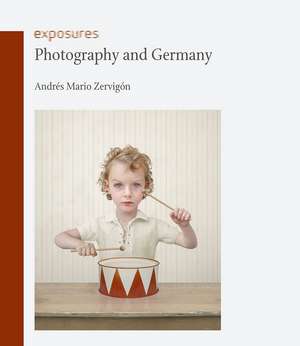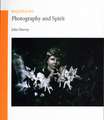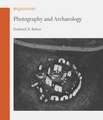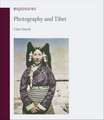Photography and Germany: Exposures
Autor Andrés Mario Zervigónen Limba Engleză Paperback – 14 iun 2017
The idea of photography in Germany evokes everything from the pioneering modernist pictures of the Weimar era to the colossal digital prints that define art photography today. But it also recalls horrifying documents of wartime atrocities and the relentless surveillance of East German citizens. Photography and Germany broadens these perceptions by examining the medium’s multi-faceted relationship with Germany’s turbulent cultural, political, and social history while rethinking the notion of German photography with fresh insights on its historical context.
Andrés Mario Zervigón covers this history from the region’s pre-photographic experiments with light-sensitive chemicals to today’s tension between analog and digital technologies. Rather than simply providing a survey of German photography, however, he focuses on how the medium, as a product of the modern age, has intervened in a fraught project of national imagining, often to productive ends but sometimes to catastrophic results. Richly illustrated with numerous previously unpublished images, Photography and Germany is the first single-authored history of photography in Germany ever published, one that deepens our broader understanding of how photography cultivates notions of a nation and its inhabitants.
Andrés Mario Zervigón covers this history from the region’s pre-photographic experiments with light-sensitive chemicals to today’s tension between analog and digital technologies. Rather than simply providing a survey of German photography, however, he focuses on how the medium, as a product of the modern age, has intervened in a fraught project of national imagining, often to productive ends but sometimes to catastrophic results. Richly illustrated with numerous previously unpublished images, Photography and Germany is the first single-authored history of photography in Germany ever published, one that deepens our broader understanding of how photography cultivates notions of a nation and its inhabitants.
Preț: 147.90 lei
Preț vechi: 177.98 lei
-17% Nou
Puncte Express: 222
Preț estimativ în valută:
28.30€ • 29.44$ • 23.37£
28.30€ • 29.44$ • 23.37£
Carte indisponibilă temporar
Doresc să fiu notificat când acest titlu va fi disponibil:
Se trimite...
Preluare comenzi: 021 569.72.76
Specificații
ISBN-13: 9781780237480
ISBN-10: 1780237480
Pagini: 224
Ilustrații: 55 color plates, 60 halftones
Dimensiuni: 191 x 220 x 23 mm
Greutate: 0.79 kg
Editura: REAKTION BOOKS
Colecția Reaktion Books
Seria Exposures
ISBN-10: 1780237480
Pagini: 224
Ilustrații: 55 color plates, 60 halftones
Dimensiuni: 191 x 220 x 23 mm
Greutate: 0.79 kg
Editura: REAKTION BOOKS
Colecția Reaktion Books
Seria Exposures
Notă biografică
Andrés Mario Zervigón is professor of the history of photography at Rutgers, the State University of New Jersey. His previous books include John Heartfield and the Agitated Image: Photography, Persuasion, and the Rise of Avant-garde Photomontage and Photography and Its Origins, the latter coedited with Tanya Sheehan.
Recenzii
“Zervigón has written the first English-language survey of the history of photographic practice in Germany from the medium’s beginnings to the present day. . . . The book's core strength resides in the author’s focus on the uses made of photography during the many periods of social and political turmoil that mark Germany’s history. In no other nation have political events so directly impacted the history of the medium as in Germany, and—in consequence of the destruction and diaspora of modernist artists by the Nazis in the 1930s—those events have in turn impacted the history of the medium throughout the Western world. The writing is informed, insightful, and lucid, and the author presents photographs in the venues of high art, commerce, journalism, propaganda, and even personal albums. The book’s design is clean and provides a good platform for the 122 well-reproduced photographic illustrations. This is a valuable addition to the literature on photography. . . . Highly recommended.”
“The Exposures series is carefully commissioned to achieve the surprisingly rare balance of offering an easily readable ‘textbook’ style approach to the medium’s multiple and complex histories and discourses, whilst simultaneously producing a specialist scholarly resource. . . . [Zervigón] brings an astute awareness of the political mobility of the photographic image to this nuanced, thorough account of photography in Germany. . . . His book undoubtedly succeeds in offering an insightful, commendably readable, and thoughtfully framed contribution.”
“Zervigón set himself the ambitious goal of chronicling the different histories of photography associated with Germany over the past 175 years. Concisely written, well-structured, and with a clear concept, [Photography and Germany] navigates this ‘sea of emulsion’ in six chronologically ordered chapters, each introduced with a representative case study that leads on to a critical question. . . . Zervigón convincingly argues that photography has been used to ‘perform the cultural work of national self-imagining’ and is still part of contemporary reflections on the country’s troubled political and cultural history. . . . A vividly written introductory tour de force through Germany’s cultural, social, and political history as reflected in photography’s many faces throughout the last 175 years.”
“While Photography and Germany is one of several in the series that explores photography in the context of a specific nation, Zervigón smartly chooses not to define a national photographic style. The inchoate and conflicted nature of German nationhood during most of the medium’s history complicates any attempt to identify what is German about German photography. And the breathtaking variety of the ways that photography has permeated modernity challenges the identification of features common to all photographic practices. Both the photographic medium and the German nation are too contested to define a stable relationship between them. Instead of presenting German photography as something consistent and visually recognizable, Zervigón incorporates an impressive range of photographic practices within each chronologically defined chapter—press photography, archival documents, film stills, amateur snapshots, and artistic practices all contribute to Zervigón’s complex presentation of Germany’s turbulent photographic history.”
"This astute and erudite narrative adroitly navigates the highly complex ground of photography in Germany since its early photograph-mad days to the present. While the editorial format limits in some ways the representation of the rich scholarship that continues to build around German photography, its merits are found in the brilliantly written overview of its subject. Essential reading for the scholar, student, and avid photography aficionado alike, Zervigón reveals through this monograph the ways in which photography mediates, narrates, and exposes the complexity of German history after 1839 and how the medium shaped the German nation and its identity."
"Zervigón is an exceptionally knowledgeable and sometimes inspired guide to the subject, skillfully weaving the history of Germany into the history of photography. The copious, high-quality illustrations are accompanied by writing of real panache, and the result not only represents an excellent introduction to the subject but includes enough original and little-known material—as well as fresh and provocative interpretations—to keep the expert engaged throughout. And one cannot ask for more than that from a book of less than forty thousand words."
"Zervigón creates an engaging read by connecting his history with a vivid selection of pictures, most of them unfamiliar to his readers. . . . A book like this, resplendent with strategically chosen, powerful imagery, is in itself a work of photomontage. . . . Lately, nationalism is a vexed issue, and Zervigón’s book gives us a valuable photographic perspective against which to consider it."
“The book at hand is an excellent introduction to German photography: carefully researched and well written. It is also superbly designed, printed, and illustrated (with many broad sections in color). Even the price . . . is sensational. Photography and Germany belongs in every good photography library. . . . The author questions some of the apparent certainties of German photo history, challenging assumptions big and small.”
“Photography can be an agent of memory and history, giving shape to conflictual understandings of national identity. Photography AND Germany persuasively juxtaposes the fractured history of modern Germany and the multi-layered evolution of German photography in politics and the arts, the public and the private sphere. An eminently readable book and a model analysis of the rise and the effects of a visual medium once it had begun to saturate everyday life.”
“Through a powerful interpretation of outstanding examples, Andrés Mario Zervigón provides an exciting narrative of Germany’s troubled encounter with modernity. A brilliantly written survey which is both an indispensable introduction into the history of German photography and a significant contribution to our understanding of the manifold relationship between the medium and the German society.”





